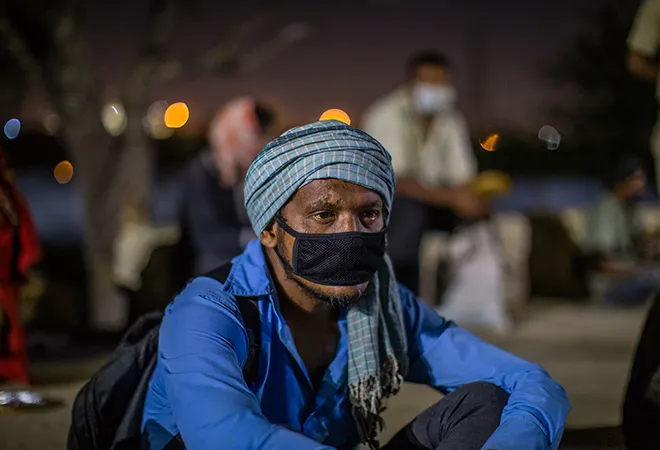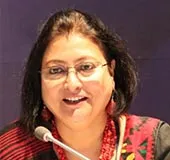
The COVID-19 pandemic has brought about unimaginable hardships for migrant workers largely employed in India’s informal sectors. Last year, when a sudden national lockdown was declared to curb the spread of COVID-19, these migrant workers were stuck without any socio-economic and health security in the cities where they worked, unable to return to their native places. Images of economic migrants desperately trying to return home by walking on foot amidst a series of challenges like lack of transportation, potential starvation and destitution, fear of COVID-19, social prejudice, and administrative antagonism, brought their vulnerability to the forefront.
Subsequently, certain relief measures ensuring free availability of food, temporary shelter, and transport arrangements, though delayed, were provided by the Centre as well as state governments. However, as several studies have suggested, the welfare schemes, though well-intentioned, have had massive glitches and inadequacies in their implementation, keeping a major section of needy migrants deprived of such relief measures.
Challenges of the second wave
As a deadlier second wave of COVID-19 hit India earlier this year, it compelled most states to impose further lockdowns leading to a dwindling of economic activities. The already suffering economic migrants—a major section of whom had barely started recovering from the shock of the first wave and had resumed their work in cities—once again stared at another round of livelihood and health crises.
In second wave, poor migrants’ situation worsened. First, as the migrant workers worked with extremely low wages, the sudden loss of livelihood for months coupled with costs for travelling home and sustaining their family during the first wave had exhausted all their savings by the time second wave arrived. Second, unlike the first wave when the nationwide lockdown brought substantial public attention to their sufferings, the absence of such national lockdown this time around gave limited coverage to their plight. However, during the peak of the second wave, several states imposed prolonged lockdowns that further increased livelihood losses and restricted inter-state movements made it difficult for the migrants to travel back home. Third, unlike the first wave, the second wave saw a rapid spike in the COVID-19 infections in rural areas, making the return of migrant workers to their villages more difficult. Fourth, as the coronavirus cases increased manifold, apart from the economic insecurity, a health crisis also loomed large for the already vulnerable migrant workers. Despite governmental assurances, judicial directives and the rolling out of welfare schemes, their precarity largely remained intriguing in the second wave and after.
As the migrant workers worked with extremely low wages, the sudden loss of livelihood for months coupled with costs for travelling home and sustaining their family during the first wave had exhausted all their savings by the time second wave arrived.
Multiple vulnerabilities
To understand why the migrant workers’ crisis continues unabated, despite certain immediate relief measures from the state, it is important to delve into the multiple deficiencies that have always enfeebled their basic citizenship rights, while they continue to serve as the crucial labour force in India’s major urban conglomerates. These migrant workers leave their native homes in search of better means of livelihood in metro cities like Delhi, Bangalore, Mumbai, Ahmedabad, and Chennai, amongst other cities. They are often engaged in menial jobs with meagre income and no social security as daily wage labourers, domestic help, rickshaw pullers, and other vocations under extremely harsh and unfavourable circumstances. The major factors that create multiple vulnerabilities of the migrant workers are economic and food insecurity, harsh living conditions, health hazards, social prejudice, and political exclusion, resulting in a continuous state of precarity that COVID-19 further aggravated.
Economic hardship
The informal nature of their employment compels migrant workers to work for very low wages under extremely harsh conditions for long working hours. The casual nature of their terms of employment deprives them of employment-related security and they are left at the mercy of their employers with their wages often being irregular. As the second wave raged, a CMIE report found that “of the total 2.25 crore jobs lost in April-May 2021, 1.72 crore were of daily wage earners”. In such a situation, without robust cash transfers from the state, there economic situation dwindled rapidly.
Food insecurity
Their economic hardship is coupled by food insecurity. As the migrant workers’ ration cards remain with their families in their native villages, they are not entitled to subsidised food in their work cities as they are considered ‘outsiders’ who cannot use the ration cards registered elsewhere. So, unlike the local poor, the migrants had to spend a substantial portion of their income on buying food. Aajeevika Bureau’s 2020 ground report from Ahmedabad suggests that lack of proper local residential documents also deprives them of legal gas connections, which compels them to purchase gas cylinder at much higher prices or use wood as cooking fuel. As the migrants need to send money home to families who depend on their income, such financial needs entrap them into a vicious cycle of indebtedness. Stranded Workers Action Committee (SWAN)’s recent report noted that 76 percent of workers who spoke to them during the pandemic had only INR 200 or even less for sustenance. Job losses, negligible savings, and lack of documentation for accessing free food created unprecedented challenges for poor migrants in the cities.
As the migrant workers’ ration cards remain with their families in their native villages, they are not entitled to subsidised food in their work cities as they are considered ‘outsiders’ who cannot use the ration cards registered elsewhere
Harsh living conditions
As the migrants travel from their far-off native villages and homes, often from other states, they need to arrange for a living place for themselves and their family (if family is accompanying them) near their workplace to avoid spending on daily transportation to go to work. Aajeevika Bureau, during their study, found that construction workers, headloaders and restaurant/hotel staff negotiate with their employers to stay on the worksite itself, many a times with pay-cuts in exchange. Others look for affordable rented houses in slums, mess houses or worker colonies often located near main work areas. This housing is in high demand, compelling the migrants to pay higher rent, without basic sanitation and water facilities in unhygienic and crowded quarters. The ones who can’t afford shelter, sleep on footpaths, stations and bus depots of the cities. During the COVID-19 lockdown, a SWAN study observed that the migrant workers, after losing work, found it difficult to pay rent in the city and faced eviction, compelling them to travel back home by spending their limited savings.
Inadequate healthcare
The migrant workers also suffer from major health insecurity in the cities, more so during the pandemic. Ajeevika Bureau in a study in May 2021, found that 70 percent of the migrant workers they interviewed were unable to access healthcare. The report, “Unlocking the Urban” observed that as migrants comes from other states, they are, in many cases, ineligible for the state government’s subsidised healthcare facilities in the public hospitals of the cities. Moreover, as they are mostly daily wage labourers, the long queues, tedious procedures, and inaccessibility along with a ‘hostile environment’ in government hospitals takes away crucial working hours from them. Hence, they are forced to go to private healthcare facilities for treatment with extremely high expenses which they can’t afford, pushing them into huge debt. This debt increased due to COVID-19-related ailments, especially in the second wave, as the reports entitled “No country for Workers” and “Patients not Passports” noted. Women migrants suffer more as unhygienic living and sanitation conditions, inadequate nutrition and impoverishment make them vulnerable to diseases, especially pregnant and lactating mothers and children. Increased domestic violence against women during lockdown worsened their situation. With regard to COVID-19 vaccination, lack of adequate information regarding vaccine centres along with lack of access to online registration for slot booking without smart phones, administrative hassles and lack of communication, the poor migrants’ access to vaccines got delayed.
As migrants comes from other states, they are, in many cases, ineligible for the state government’s subsidised healthcare facilities in the public hospitals of the cities.
Victim of prejudice and exclusion
The material hardship of migrants in the cities worsens as deep-rooted social prejudices against the ‘outsider’ image of the ‘migrant’ labour is prevalent in the local city dwellers. Migrants were often perceived as ‘dirty’, ‘job usurpers’, ‘criminals’ and ‘anti-socials’ during COVID-19. They were seen as ‘carriers’ of the disease who are not welcome in the city while also facing similar backlash when they returned to their native villages. Further, they are subjected to harsh treatment from city administration and police for lack of documents. As the workers are not voters of the city in which they work, the political class of the city seem indifferent to their hardship.
Towards a holistic idea of protection
The vulnerabilities of migrant workers have pushed them to the margins of society as their fundamental right to life with dignity and right to freedom of movement remains compromised. The immediate ad-hoc relief measures for COVID-19 were not adequately effective to assuage the complex humanitarian crisis of the internal migrant workers in India unless a rights-based perspective of socio-economic protection is designed keeping in mind the multiple levels of their vulnerabilities. Structural changes like inter-state and Centre-State coordination on migrant workers data, and policy interventions with hassle-free documentation of migrants for easily availing government social-welfare measures and reforms in the city governance structures to treat the migrants in a humane manner, can be a much-needed starting point for the amelioration of their condition.
Arlene Noronha is an intern at ORF Kolkata.
The views expressed above belong to the author(s). ORF research and analyses now available on Telegram! Click here to access our curated content — blogs, longforms and interviews.




 PREV
PREV



